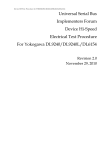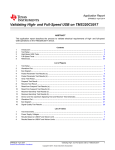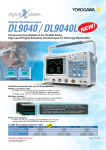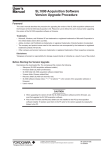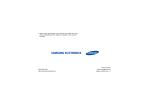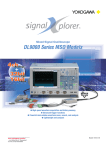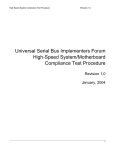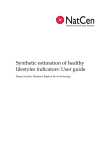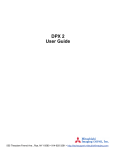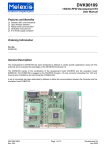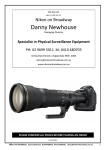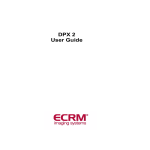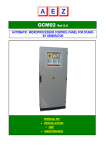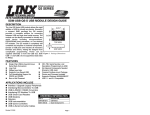Download Host High-speed Electrical Test Procedure
Transcript
Host HS Test Procedure for YOKOGAWA DL9240/DL9240L/DL6154 Universal Serial Bus Implementers Forum Host Hi-Speed Electrical Test Procedure For Yokogawa DL9240/DL9240L/DL6154 Revision 2.0 November 29, 2010 Host HS Test Procedure for YOKOGAWA DL9240/DL9240L/DL6154 Revision History Rev Date Filename Comments 1.0 2.0 July-27-2006 Nov.-29-2010 Yokogawa_HS_HOST_TestProcedure_r1.doc Yokogawa_HS_HOST_TestProcedure_r2.doc Edit for final release. Support DL6154. Please send comments via electronic mail to [email protected]. USB-IF Hi-Speed Electrical Test Procedure Copyright 2001, USB Implementers Forum, Inc. All rights reserved. 2 Host HS Test Procedure for YOKOGAWA DL9240/DL9240L/DL6154 DISCLAIMER OF WARRANTIES THIS SPECIFICATION IS PROVIDED “AS IS” AND WITH NO WARRANTIES OF ANY KIND, EXPRESS OR IMPLIED, INCLUDING, WITHOUT LIMITATION, NO WARRANTY OF NONINFRINGEMENT, NO WARRANTY OF MERCHANTABILITY, NO WARRANTY OF FITNESS FOR A PARTICULAR PURPOSE, NO WARRANTY OF TITLE, AND NO WARRANTY ARISING OUT OF ANY PROPOSAL, SPECIFICATION, OR SAMPLE, ALL OF WHICH WARRANTIES ARE EXPRESSLY DISCLAIMED. WITHOUT LIMITING THE GENERALITY OF THE FOREGOING, USB-IF AND THE AUTHORS OF THE SPECIFICATION DO NOT WARRANT OR REPRESENT THAT USE OF THE SPECIFICATION WILL NOT INFRINGE THE INTELLECTUAL PROPERTY RIGHTS OF OTHERS. USERS OF THE SPECIFICATION ASSUME ALL RISK OF SUCH INFRINGEMENT, AND AGREE THAT THEY WILL MAKE NO CLAIM AGAINST USB-IF OR THE AUTHORS IN THE EVENT OF CLAIMS OF INFRINGEMENT. USB-IF IS NOT LIABLE FOR ANY CONSEQUENTIAL, SPECIAL OR OTHER DAMAGES ARISING OUT OF THE USE OF THE SPECIFICATION. LICENSE FOR INTERNAL USE ONLY USB-IF HEREBY GRANTS A LICENSE TO REPRODUCE AND TO DISTRIBUTE THIS SPECIFICATION FOR INTERNAL USE ONLY. NO OTHER LICENSE, EXPRESS OR IMPLIED, BY ESTOPPEL OR OTHERWISE, IS GRANTED HEREWITH, AND NO LICENSE OF INTELLECTUAL PROPERTY RIGHTS IS GRANTED HEREWITH. All product names are trademarks, registered trademarks, or servicemarks of their respective owners. 3 Host HS Test Procedure for YOKOGAWA DL9240/DL9240L/DL6154 Table of Contents 1 Introduction ······················································································ 5 2 Purpose ···························································································· 5 3 3.1 3.1.1 3.1.2 3.2 3.2.1 3.2.2 3.2.3 Equipment Required ·········································································· 5 Equipment Setup················································································· 6 DL9240, DL9240L, DL6154 Digital Oscilloscope·········································· 6 Differential Probe ·············································································· 6 Operating Systems, Software, Drivers, and Setup Files································· 6 Operating Systems··············································································· 6 Special Purpose Software ······································································ 7 Test Equipment Setup Files ··································································· 7 4 4.1 4.2 4.3 4.4 4.5 4.6 4.7 4.8 4.9 4.10 4.11 Test Procedure ··················································································· 8 Test Record ······················································································· 8 Vendor and Product Information ···························································· 8 Hi-Speed Mode Compatible Device Electrical Tests····································· 8 Legacy USB Compliance Tests································································ 8 Starting the USB Compliance Test Software··············································· 9 Host Hi-Speed Signal Quality (EL_2, EL_3, EL_6, EL_7) ·····························12 Host Controller Packet Parameters (EL_21, EL_22, EL_23, EL_25, EL_55) ········19 Host Disconnect Detect (EL_36, EL_37) ···················································28 Host CHIRP Timing (EL_33, EL_34, EL_35) ··············································29 Host Suspend/Resume timing (EL_239, EL_41) ········································36 Host Test J/K, SE0_NAK (EL_8, EL_9) ···················································42 Appendix A Host Hi-Speed Electrical Test Data ················································48 A.1 Vendor and Product Information ··························································48 A.2 Legacy USB Compliance Tests ······························································49 A.3 Host Hi-Speed Signal Quality (EL_2, EL_3, EL_6, EL_7) ·····························50 A.4 Host Controller Packet Parameters (EL_21, EL_22, EL_23, EL_25, EL_55) ········50 A.5 Host Disconnect Detect (EL_36, EL_37) ···················································52 A.6 Host CHIRP Timing (EL_33, EL_34, EL_35) ··············································52 A.7 Host Suspend/Resume timing (EL_239, EL_41) ········································53 A.8 Host Test J/K, SE0_NAK (EL_8, EL_9) ···················································54 Appendix B USB Electrical Analysis Tool (USBET) ·····································55 B.1 About USBET ··················································································55 B.2 How to start USBET ·······································································55 B.3 Low-Speed/Full-Speed/Hi-Speed Signal Quality Test ························55 B.4 Inrush Current Test·············································································56 4 Host HS Test Procedure for YOKOGAWA DL9240/DL9240L/DL6154 1. Introduction The USB-IF Hi-Speed Electrical Test Procedures are developed by the USB 2.0 Compliance Committee under the direction of USB-IF, Inc. There are three Hi-Speed Electrical Test Procedures. The Host Hi-Speed Electrical Test Procedure is for EHCI host controllers. The Hub Hi-Speed Electrical Test Procedure is for high-speed capable hubs. The Device Hi-Speed Electrical Test Procedure is for highspeed capable devices. The Hi-Speed Electrical Compliance Test Procedures verify the electrical requirements of high-speed USB operation of these devices designed to the USB 2.0 specification. In addition to passing the Hi-Speed test requirements, Hi-Speed capable products must also complete and pass the applicable legacy compliance tests identified in these documents in order to be posted on the USB-IF Integrators List and use the USB-IF logo in conjunction with the said product (if the vendor has signed the USB-IF Trademark License Agreement) 2. Purpose This USB-IF Hi-speed Electrical Test Procedure documents a series of tests used to evaluate USB peripherals and systems operating at hi-speed. These tests are also used to evaluate the hi-speed operation of USB silicon that has been incorporated in ready-to-ship products, reference designs, proofs of concept and one-of-a-kind prototypes of peripherals, add-in cards, motherboards, or systems. This test procedure makes reference to the test assertions in the USB-IF USB2.0 Electrical Test Specification, Version 1.00. This Host USB-IF Hi-speed Electrical Test Procedure is one of the three USB-IF Hi-speed Electrical Compliance Test Procedures. The other two are Hub USB-IF Hi-speed Electrical Test Procedure and Device USB-IF Hi-speed Electrical Test Procedure. The adoption of the individual procedures based on the device class makes it easier to use. 3. Equipment Required The commercial test equipment listed here are base on positive experience by the USB-IF members in executing the USB hi-speed electrical tests. This test procedure is written with a set of specific models we use to develop this procedure. In time, there will be other equivalent or better test equipment suitable for use. Some minor adaptation of the procedure will be required in those cases. • • Digital Oscilloscope System • Yokogawa DL9240, DL9240L or DL6154: qty = 1 (Requires the Ethernet main unit option) • Yokogawa PBA2500 Probe : qty = 2 ・ Yokogawa PBA2500 Probe attachment : qty = 2set • Yokogawa PBD2000 Probe : qty = 1 • Yokogawa PBD2000 Probe attachment : qty = 1set • Yokogawa 500 MHz Passive Probe1 (701943 or 701939) : qty = 2(Legacy USB Compliance Test) 1 Use 701943 with the DL9240/DL9240L and 701939 with the DL6154. 3 ½ Digital Multimeter · Yokogawa Meter & Instrument 733 or 734, or equivalent : qty = 1 · Mini-clip DMM lead, one each in black and red : qty = 1set 5 Host HS Test Procedure for YOKOGAWA DL9240/DL9240L/DL6154 • Hi-Speed USB Electrical Test Fixtures · Yokogawa USB 2.0 Test Fixture : qty =1 · 5 V Test Fixture Power Supply : qty =1 (included with Yokogawa USB 2.0 Test Fixture) • Miscellaneous Cables ・ 1 m USB-IF compliant USB cable : qty = 1 (for the Legacy USB Compliance Test: qty = 5) ・ 5 m USB-IF compliant USB cable : qty = 6 (Legacy USB Compliance Test) ・ Modular AC power cord : qty = 1 • Hi-Speed USB Test Bed Computer This is the computer that hosts a USB 2.0 compliance host controller for the Hi-Speed hub or device electrical test, or serves as a test bed host for a USB 2.0 host controller under test. The OS on this computer is Windows 2000 or XP Professional. Please refer to the Hi-Speed Electrical Test Setup Instruction for steps to configure this computer. • · • · · USB Hub Full-Speed USB-IF compliant USB Hub : qty = 1(Legacy USB Compliance Test) · Hi-Speed USB-IF compliant USB Hub : qty = 1(for the Legacy USB Compliance Test: qty = 4) USB Device (Legacy USB Compliance Test) Full-Speed USB-IF compliant PC Camera : qty = 1 USB-IF compliant Mouse : qty = 1 3.1. Equipment Setup 3.1.1. DL9240, DL9240L,DL6154 Digital Oscilloscopes 1. 2. 3. 4. Connect the PBD2000 Differential Probe to CH1 of the oscilloscope. Place the attachment on the tip of the differential probe. Connect the PBA2500 Active Probe to CH2 and CH3 of the oscilloscope. Turn ON the power to the oscilloscope and allow a 30 minute warm-up prior to use. 3.1.2. Differential Probe For information on adjusting the offset voltage remaining after warm-up (residual offset voltage), see “PBD2000 Differential Probe User’s Manual” (IM701923-01E). Note: In certain test situations, there may not be a ground connection between the oscilloscope and the DUT. This may lead to the signal being seen by the differential probe to be modulated up and down due to the mid- frequency switching power supply. Connecting the oscilloscope ground to the DUT ground will be required to establish a common ground reference. Phase-correct the probe if necessary. 3.2. Operating Systems, Software, Drivers, and Setup Files 3.2.1. Operating Systems Microsoft Windows 2000 or XP Professional is required on the Hi-Speed Electrical Test Bed Computer. Please refer to the Hi-Speed Electrical Test Setup Instruction for steps to configure these computers. 6 Host HS Test Procedure for YOKOGAWA DL9240/DL9240L/DL6154 3.2.2. Special Purpose Software The following special purpose software is required. Yokogawa USB Compliance Test Software( busXplorer-USB) – To be used in the Hi-Speed Electrical Test Bed Computer. Hi-Speed Electrical Test Tool Software(USBHSET) – To be used in the Hi-Speed Electrical Test Bed Computer. Note: Hi-Speed Electrical Test Tool(USBHSET) is official analysis tool of USB-IF and downloadable from the following USB-IF site. http://www.usb.org/developers/tools USB Electrical Analysis Tool(USBET) - To be used in the Hi-Speed Electrical Test Bed Computer. Note: USBET is official analysis tool of USB-IF and downloadable from the following USB-IF site. http://www.usb.org/developers/tools/ Please refer to the Appendix B.1 of this document for details. Please refer to the Hi-Speed Electrical Test Setup Instruction for steps to configure these computers. Proprietary EHCI Driver Stack - The Hi-Speed Electrical Test Tool software requires the use of a proprietary EHCI driver stack. The use of this proprietary EHCI driver stack facilitates the electrical testing that requires direct control of the command registers of the USB EHCI host controllers. The end result much more robust test bed environment. Since the proprietary EHCI driver stack is designed for debug and test validation purposes, this driver stack does not support the normal functionality as found in the EHCI drivers from Microsoft (or the device vendor). An automatic driver stack switching function has been implemented into the Hi-Speed Electrical Test Tool for easy switching between the proprietary EHCI driver stack and that from Microsoft. Upon invocation of the HS Electrical Test Tool software, the driver stack will automatically switch to the Intel proprietary EHCI driver stack. Upon exit of the HS Electrical Test Tool software, the driver stack will automatically switch to the Microsoft EHCI driver stack. 3.2.3. Test Equipment Setup Files Setup file for DL9240/DL9240L/DL6154 is available at the following site. http://www.usb.org/developers/docs#comp_test_procedures No setup file is needed for DL9240/DL9240L/DL6154 if the Yokogawa USB Compliance Test Software (busXplorler-USB, Type 701985/F30) is installed on the Test Bed Computer Setup file for DG2040can be obtained by extracting ‘USBHSET.EXE’. For details about 'USBHSET.EXE', please refer to the following web site. http://www.usb.org/developers/docs#comp_test_procedures 7 Host HS Test Procedure for YOKOGAWA DL9240/DL9240L/DL6154 4. Test Procedures 4.1. TEST Record Appendix A contains the test result entry forms for these test procedures. Please make copies of Appendix A for use as test record documentation for compliance test submission. All fields must be filled in. Fields not applicable for the device under test should be indicated as N/A, with an appropriate note explaining the reason. The completed test result shall be retained for the compliance test submission. In addition to the hardcopy test record, the electronic files from the signal quality, and power delivery (drop and droop) shall be retained for compliance test submission. 4.2. Vendor and Product Information Collect the following information and enter into a copy of the test record in Appendix A before performing any tests. 1. Test date 2. Vendor name 3. Vendor address, phone number, and contact name 4. Test submission ID number 5. Product name 6. Product model and revision 7. USB silicon vendor name 8. USB silicon model 9. USB silicon part marking 10. USB silicon stepping 11. Test conducted by 4.3. Hi- Speed Mode Compatible Host Electrical Tests Perform the following six tests. Host Hi-Speed Signal Quality (EL_2, EL_3, EL_6, EL_7) Host Controller Packet Parameters (EL_21, EL_22, EL_23, EL_25, EL_55) Host CHIRP Timing (EL_33, EL_34, EL_35) Host Suspend/Resume Timing (EL_39, EL_41) Host Test J/K, SE0_NAK (EL_8, EL_9) 4.4. Legacy USB Compliance Tests In addition to the hi-speed electrical tests described in this document, the device under test must also pass the following compliance tests applicable to hi-speed capable the EHCI Host Controller: Full speed/Low Speed Downstream Signal Quality Drop/Droop Interoperability Perform all these tests and record the measurements and summarized PASS/FAIL status in Appendix A. Note: This manual describes Hi-Speed electrical tests and legacy USB compliance tests, but does not describe interoperability tests. For these test procedures, see “USB-IF Full and Low Speed Compliance Test Procedure” (available at: http://www.usb.org/developers/) issued by the USB-IF. 8 Host HS Test Procedure for YOKOGAWA DL9240/DL9240L/DL6154 4.5. Starting the USB Compliance Test Software 1. Start the busXplorer-USB. The environment settings dialog box as shown below opens. Note: This manual does not describe all of the functions of the busXplorer-USB. For functions not described herein (such as operation of the results display button), see “USB Compliance Test User’s Manual” (IM701985-61E). 2. 3. Click the [Host] button under Test Category in the environment settings. Select the test items to execute under Speed Type according to the DUT. Select HS and execute the test. All electrical tests are performed. If you select FS/LS and execute the test, only the tests required for FS/LS are executed. 4. Connect the test bed computer and digital oscilloscope via Ethernet. 5. Turn ON the power to the digital oscilloscope. 6. Click the [Connection] button in the dialog box. The connection settings dialog box is displayed. Note: If connection destinations are already registered, they are displayed in a list. If the digital oscilloscope to use appears in the list, select it, then click the [Connect] button to start establishing communication with the digital oscilloscope. 9 Host HS Test Procedure for YOKOGAWA DL9240/DL9240L/DL6154 7. Click the [Add] button. The connection method selection dialog box in the figure below opens. Note: The busXplorer-USB supports Ethernet only. 8. Select Network, enter the IP address of the digital oscilloscope in the Server box, then click the [OK] button. Enter the user name and password if required. 9. A connection settings dialog box is displayed. Select the digital oscilloscope then click the [Connect] button. If you select a connection destination in the list and click Properties, the connection method selection dialog box appears allowing you to change settings. If you select a connection destination in the list and click Delete, the selected connection destination is deleted. The maximum number of connection destinations that can be registered is 16. 10. Click the [Working folder] button. A dialog box for browsing folders is displayed. 10 Host HS Test Procedure for YOKOGAWA DL9240/DL9240L/DL6154 11. Specify a working folder and click the [OK] button. The following data are saved in the working folder. Test results files in HTML format These are displayed by clicking the [Detail] button in the test results display dialog box. Digital oscilloscope screen image data These are displayed by clicking the [Image] button in the test results display dialog box. Waveform data captured by Digital oscilloscope File names are automatically assigned to data files. To set a file name, choose Fix in the File Naming box, and enter a file name in the box (of up to twenty alphanumeric characters). Note: Environment settings can be saved and recalled. To save settings, click the [Save settings] button to display a dialog box for entering a file name and save location. To load settings, click the [Load settings] button to display a dialog box for opening previously saved settings files. To save or change the display color or format of the waveform data displayed by the busXplorer-USB, click the [Option] button, then modify settings as needed. 11 Host HS Test Procedure for YOKOGAWA DL9240/DL9240L/DL6154 4.6. Host Hi-Speed Signal Quality (EL_2, EL_3, EL_6, EL_7) USB 2.0 Electrical Test Specification EL_2 A USB 2.0 Hi-Speed transmitter data rate must be 480Mb/s ±0.05%. EL_3 A USB 2.0 downstream facing port must meet Template 1 transform waveform requirements measured at TP2 (each host downstream port). EL_6 A USB 2.0 HS driver must have 10% to 90% differential rise and fall times of greater than 500ps. EL_7 A USB 2.0 HS driver must have monotonic data transitions over the vertical openings specified in the appropriate eye pattern template. Instruments Used Name DL9240/DL9240L/DL6154 Digital Oscilloscope PBD2000 Differential Probe PBD2000 Probe attachment USB-IF compliant 1 m USB 2.0 cable Test bed computer USB compliance test fixture 5 V power supply for test fixture Quantity 1 1 1set 1 1 1 1 1. Executing the Test Click the [Test Exec] button in the busXplorer-USB to display the Host Test selection dialog box. 2. Click the [HS Signal Quality Test] button in the dialog box. The Host HS Signal Quality Test dialog box is displayed. 12 Host HS Test Procedure for YOKOGAWA DL9240/DL9240L/DL6154 3. Enter the repeat number from 1(default) to 50 in the Number of Repetition input box. 4. If necessary, enter a comment for the test in Comment text box. The comment is saved together with test results and displayed in the Test Result Dialog box. 5. Click the [Next] button in the dialog box of the busXplorer-USB. The connection diagram as shown below is displayed. 6. Connect the port under test of the host controller to the CN2 connector of the HOST SQ TEST block. 7. Connect the PBD2000 Differential Probe to CH1 of the digital oscilloscope. Note: 8. After connecting the probe, heat emitted from the probe causes the offset voltage to drift. The probe should nearly stabilize about thirty minutes after applying power. Connect the differential probe to the attachment on the tip to CN3 on the HOST SQ TEST block. For the polarity, match up the plus side on the differential probe to D+ (the D+ pin at CN3) and the minus side to D- (the D- pin at CN3). 13 Host HS Test Procedure for YOKOGAWA DL9240/DL9240L/DL6154 9. Click the [Next] button. Following the instructions in the dialog box of the busXplorer-USB, invoke the HS Electrical Test Tool on the test bed computer. The HS Electrical Test Tool main menu is displayed, and the host controller is displayed under Select Host Controller For Use in Testing. Note: If the host under test is an embedded host, set its test mode to an appropriate mode by using the dedicated tool for it. 10. Select Host Controller/System under Select Type Of Test in the HS Electrical Test Tool. 11. Click the [TEST] button in the HS Electrical Test Tool to enter the HS Electrical Test Tool - Host Test menu. 12. Click [Next] button in the dialog box of the busXplorer-USB. Following the instructions in the dialog box, select TEST PACKET from the Port Control drop down menu and set the target port number in the HS Electrical Test Tool then click the [EXECUTE] button. 13. Click the [Next] button in the dialog box of the busXplorer-USB. Following the instructions in the dialog box, check the digital oscilloscope screen to confirm that a trigger activates and packet data is displayed. If the trigger does not activate, adjust the trigger level as needed. Click the [Update] button to update the image of waveform in the dialog box of the busXplorer-USB. 14 Host HS Test Procedure for YOKOGAWA DL9240/DL9240L/DL6154 14. Click [Get TSV] button in the dialog box of the Test Software to save the waveform data for USBET. The waveform TSV file is saved in the working folder. 15. Activate ‘USB Electrical Analysis Tool (USBET)’. Select [Signal Quality] tab, click [Browse] button of USBET and specify the waveform data file (tsv file). Set an appropriate Test Type (HSNE) then click [TEST] to start analysis. Check the test report generated by USBET and verify the result of the test. Note: To know how to use USBET, please refer to Appendix B of this document. 16. Click [Next] button in the dialog box of the busXplorer-USB. Following the instructions in the dialog box, using zoom/cursor functions of oscilloscope, measure rise/fall time of the waveform and record the values to input text fields in the dialog box. They must be more than 500ps. ・When [Next] button is clicked, the measured value is judged and Fail message will be displayed if the result is failed. 15 Host HS Test Procedure for YOKOGAWA DL9240/DL9240L/DL6154 17. Click the [Next] button in the dialog box of the busXplorer-USB. The test results dialog box as shown below is displayed. 18. Click the [Next] button of the dialog box of the busXplorer-USB, repeat steps 13-17, and execute the test the number of times specified in “Number of Repetition.”. When the number of tests is completed, the test result dialog box is displayed. 16 Host HS Test Procedure for YOKOGAWA DL9240/DL9240L/DL6154 Click the [Detail] button to display the test results by Web Browser as shown below. Click the [Image] button to display an image of the digital oscilloscope screen. Click the [Analyze] button to start Xviewer and display the waveform data. Xviewer must already have been installed. Note: Test result shown by Web Browser is saved in the directory specified as the working folder for the busXplorer-USB. Test results can also be confirmed when displayed in the results display dialog box by clicking the results display button in the Test Software. 19. Record the test results in EL_2, EL_3, EL_6, and EL_7. ・Appendix A contains the test result entry form for this test procedure. If necessary,please make copies of Appendix A for use as test record documentation for compliance test submission. ・All files created during tests are saved in the directory specified as the working folder for the 17 Host HS Test Procedure for YOKOGAWA DL9240/DL9240L/DL6154 busXplorer-USB. 20. Repeat steps 2-19 for all ports of the host controller. . 18 Host HS Test Procedure for YOKOGAWA DL9240/DL9240L/DL6154 4.7. Host Controller Packet Parameters (EL_21, EL_22, EL_23, EL_25, EL_55) USB 2.0 Electrical Test Specification EL_21 The SYNC field for all transmitted packets (not repeated packets) must begin with a 32-bit SYNC field. EL_22 When transmitting after receiving a packet, hosts and devices must provide an inter-packet gap of at least 8 bit times and not more than 192 bit times. EL_23 Hosts transmitting two packets in a row must have an inter-packet gap of at least 88 bit times and not more than 192 bit times. EL_25 The EOP for all transmitted packets (except SOFs) must be an 8 bit NRZ byte of 01111111 without bit stuffing. (Note, that a longer EOP is waiverable) EL_55 Hosts transmitting SOF packets must provide a 40 bit EOP without bitstuffing where the first symbol of the EOP is a transition from the last data symbol. Instruments Used Name DL9240/DL9240L/DL6154 Digital Oscilloscope PBD2000 Differential Probe PBD2000 Probe attachment USB-IF compliant 1 m USB 2.0 cable USB-IF Compliant Hi-Speed USB Hub Test bed computer (PC with the host controllers to be tested installed) USB compliance test fixture 5 V power supply for test fixture Quantity 1 1 1set 1 1 1 1 1 1. Executing the Test Click the [Test Exec] button in the busXplorer-USB to display the Host Test selection dialog box. 2. Click the [HS Packet Parameter Test] button in the dialog box. The Host HS Packet Parameter Test dialog box opens. 19 Host HS Test Procedure for YOKOGAWA DL9240/DL9240L/DL6154 3. Enter the repeat number from 1(default) to 50 in the Number of Repetition input box. 4. If necessary, enter a comment for the test in Comment text box. The comment is saved together with test result and displayed in the Test Result Dialog box. 5. If you wish to change the judgment range, you can edit the judgment criteria for EL_21, EL_25, EL23, EL22, and EL55. Default values for the judgment criteria are as follows: EL_21(1st packet) Min.: 31.500 bits, Max.: 32.500 bits EL_21(2nd packet) Min.: 31.500 bits, Max.: 32.500 bits EL_25 Min.: 7.5000 bits, Max.:8.5000 bits EL_23 Min.: 88.000 bits, Max.: 192.00 bits EL_22 Min.: 8.000 bits, Max.: 192.00 bits EL_55 Min.: 39.500 bits, Max.: 40.500 bits If you click the [Default] button after changing the judgment range, the default values of the judgment range are restored. 6. Click the [Next] button in the dialog box of the busXplorer-USB. The connection diagram a shown below is displayed. 20 Host HS Test Procedure for YOKOGAWA DL9240/DL9240L/DL6154 7. Turn ON the power to the test fixture and verify that the green power supply LED 1 is lit. 8. Connect the USB-IF compliant Hi-Speed USB hub (upstream port side) to the CN31 connector of the DEVICE SQ TEST block and turn ON the power to the hub. 9. Connect the host controller port under test to the CN34 connector of the DEVICE SQ TEST block using a 1 m USB cable. 10. Connect the PBD2000 Differential Probe to CH1 of the digital oscilloscope. Note: After connecting the probe, heat emitted from the probe causes the offset voltage to drift. The probe should nearly stabilize about thirty minutes after applying power. 11. Connect the differential probe to the attachment on the tip to CN32 on the DEVICE SQ TEST block. For the polarity, match up the plus side on the differential probe to D+ (the D+ pin at CN32) and the minus side to D- (the D- pin at CN32). Note: The use of the Device Hi-Speed Signal Quality test fixture makes it possible to trigger on packets generated by the device because the differential probe is located closer to the device transmitter, hence the device packets are larger in amplitude. 12. Click the [Next] button in the dialog box of the busXplorer-USB. Following the instructions displayed in the dialog box, place SW8 of the test fixture to the INIT position. Verify LED2 of the test fixture is lit. 13. Click [Next] button in the dialog box of the busXplorer-USB. Following the instructions in the dialog box, select SINGLE STEP GET DEV DESC from 21 Host HS Test Procedure for YOKOGAWA DL9240/DL9240L/DL6154 the Downstream Device Control drop down menu in the HS Electrical Test Tool then click the [EXECUTE] button. If not already running, start the HS Electrical Test Tool. Select Host Controller/System under Select Type of Test, click the TEST button, then confirm the above. Note: If the host under test is an embedded host, set its test mode to an appropriate mode by using the dedicated tool for it. 14. Click the [Next] button in the dialog box of the busXplorer-USB. Following the instructions in the dialog box, check the digital oscilloscope screen to confirm that a trigger activates and packet is displayed. • • If the trigger does not activate, adjust the trigger level as needed. Then, select SINGLE STEP GET DEV DESC again from the Device Command drop down menu in the HS Electrical Test Tool, and click the [EXECUTE] button again. Click the [Update] button to update the image of waveform in the dialog box of the busXplorer-USB. 15. Confirm the Sync field of the 1st packet (EL_21). Using the digital oscilloscope’s zoom function, adjust the zoom position on the 1st packet. Then set the cursors of the digital oscilloscope on the start and the end points of the Sync field of the 1st packet. The Sync field must be 32bits. Note: Click the [Update] button to update the image of waveform in the dialog box. When [Next] button is clicked, the measured value is judged and Fail message will be displayed if the result is failed. When setting the cursor on the Sync field, note that the Sync field starts from the Hi-Speed idle transitions to a falling edge. Count both rising and falling edges until the first two consecutive 1’s and include the first 1. 22 Host HS Test Procedure for YOKOGAWA DL9240/DL9240L/DL6154 16. Click the [Next] button in the dialog box of the busXplorer-USB. To measure the Sync field of the 2nd packet (EL_21), adjust the zoom position on the EOP of the 2nd packet and set the cursors on the start and the end points of the Sync field of the 2nd packet. The Sync field must be 32bits. Note: Click the [Update] button to update the image of waveform in the dialog box. When [Next] button is clicked, the measured value is judged and Fail message will be displayed if the result is failed. When setting the cursor on the Sync field, note that the Sync field starts from the Hi-Speed idle transitions to a falling edge. Count both rising and falling edges until the first two consecutive 1’s and include the first 1. 17. Click the [Next] button in the dialog box of the busXplorer-USB. To measure the EOP width (EL_25), adjust the zoom1 position of the EOP of the 2nd packet. Then set the cursors on the start and the end points of the EOP pulse of the 2nd packet in zoom1. The EOP width must be 8bits. Note: Note that EOP could appear as a falling pulse or a rising pulse. When [Next] button is clicked, the measured value is judged and Fail message will be displayed if the result is failed. 23 Host HS Test Procedure for YOKOGAWA DL9240/DL9240L/DL6154 18. Click the [Next] button in the dialog box of the busXplorer-USB. To measure the gap between packets (EL_23), adjust zoom1 position to the end of the 1st packet (from host) and zoom2 position to the start of the 2nd packet (from host). Then set the cursors on the end point of the 1st packet in zoom1 and the start point of the 2nd packet in zoom2. The requirement of the gap is between 88bits and 192bits. Click the [Update] button to update the image of waveform in the dialog box. When [Next] button is clicked, the measured value is judged and Fail message will be displayed if the result is failed. 19. Click the [Next] button in the dialog box of the busXplorer-USB. Following the instructions in the dialog box, select SINGLE STEP GET DEV DESC from the Downstream Device Control drop down menu in the HS Electrical Test Tool, then click the [STEP] button two times. 24 Host HS Test Procedure for YOKOGAWA DL9240/DL9240L/DL6154 20. Click the [Next] button in the dialog box of the busXplorer-USB. Following the instructions in the dialog box, check the digital oscilloscope screen to confirm its trigger activates and packets from the host and device are displayed. • • If the trigger does not activate, adjust the trigger level as needed. Then, select SINGLE STEP GET DEV DESC again from the Device Command drop down menu in the HS Electrical Test Tool, and click the [STEP] button again. Click the [Update] button to update the image of waveform in the dialog box of the busXplorer-USB. 21. To measure the gap between packets (EL_22), adjust zoom1 position to the end of the 2nd packet (from Device) and zoom2 position to the start of the 3rd packet (from Host). Then set the cursors on the end point of the 2nd packet in zoom1 and the start point of the 3rd packet in zoom2. The gap must be between 8bits and 192 bits. When [Next] button is clicked, the measured value is judged and Fail message will be displayed if the result is failed. 22. Click [Next] button in the dialog box of the busXplorer-USB. To measure the EOP Width(EL_55), adjust zoom1 position to the EOP of SOF. Then set the cursors on the start point of the EOP and the end point of the EOP in zoom1. The EOP width must be 40bits. Click the [Update] button to update the image of waveform in the dialog box. When [Next] button is clicked, the measured value is judged and Fail message will be displayed if the result is failed. 25 Host HS Test Procedure for YOKOGAWA DL9240/DL9240L/DL6154 23. Click the [Next] button in the dialog box of the busXplorer-USB. The test results dialog box is displayed. 24. Click the [Next] button in the dialog box of the busXplorer-USB, repeat steps 13-23, and execute the test the number of times specified in “Number of Repetition.” When the number of tests is completed, the test results dialog box as shown below is displayed. Click the [Detail] button to display the test results by Web Browser. Click the [Image] button to display an image of the digital oscilloscope screen. Click the [Analyze] button to start Xviewer and display the waveform data. Xviewer must already have been installed. 26 Host HS Test Procedure for YOKOGAWA DL9240/DL9240L/DL6154 25. Record the test results in EL_21, EL_25, EL_23, EL_22, and EL_55. ・Appendix A contains the test result entry form for this test procedure. If necessary,please make copies of Appendix A for use as test record documentation for compliance test submission. ・All files created during tests are saved in the directory specified as the working folder for the busXplorer-USB. 26. Repeat steps 2-25 for all ports of the host controller. 27. Remove the differential probe from the test fixture. 27 Host HS Test Procedure for YOKOGAWA DL9240/DL9240L/DL6154 4.8. Host Disconnect Detect (EL_36, EL_37) Please contact the independent test facilities to perform the Disconnect Test. Yokogawa Test Fixture and busXplorler-USB do not support this test. Note Disconnect testing is required for uncertified hub silicon and host silicon or certified silicon using an uncertified PHY. USB 2.0 Electrical Test Specification EL_36 A USB 2.0 downstream facing port must not detect the high-speed disconnect state when the amplitude of the differential signal at the downstream facing driver’s connector is ≧525mV. EL_37 USB 2.0 downstream facing port must detect the hi-speed disconnect state when the amplitude of the differential signal at the downstream facing driver’s connector is ≦625mV. 28 Host HS Test Procedure for YOKOGAWA DL9240/DL9240L/DL6154 4.9. Host CHIRP Timing (EL_33, EL_34, EL_35) USB 2.0 Electrical Test Specification EL_33 Downstream ports start sending and alternating sequence of Chirp K’s and Chirp J’ s within 100 µs after the device Chirp K stops. EL_34 Downstream port Chirp K and Chirp J durations must be between 40us and 60us duration. EL_35 Downstream ports begin sending SOFs within 500 µs and not sooner than 100 µs from transmission of the last Chirp (J or K). Instruments Used Name DL9240/DL9240L/DL6154 Digital Oscilloscope PBA2500 Active Probe PBA2500 Probe attachment USB-IF compliant 1 m USB 2.0 cable USB-IF Compliant Hi-Speed Hub Test bed computer USB compliance test fixture 5 V power supply for test fixture Quantity 1 2 2 sets 1 1 1 1 1 1. Executing the Test Click the [Test Exec] button in the busXplorer-USB to display the Host Test selection dialog box. 2. Click the [HS CHIRP Timing Test] button in the dialog box. The Host HS CHIRP Timing Test dialog box is displayed. 29 Host HS Test Procedure for YOKOGAWA DL9240/DL9240L/DL6154 3. Enter the repeat number from 1(default) to 50 in the Number of Repetition input box. 4. If necessary, enter a comment for the test in Comment text box. The comment is saved together with test result and displayed in the Test Result Dialog box. 5. If you wish to change the judgment range, you can edit the judgment criteria for EL_33, EL_34, and EL_35. Default values for the judgment criteria are as follows: EL_33 Max.: 100 µs EL_34 (Chirp K,J) Min.: 40.0 µs, Max.: 60.0 µs EL_35 Min.: 100 µs, Max.: 500.0 µs If you click the [Default] button after changing the judgment range, the default values of the judgment range are restored. 6. Click the [Next] button. A connection diagram as shown below is displayed. 7. Turn ON the power to the test fixture and verify that the green power supply 30 Host HS Test Procedure for YOKOGAWA DL9240/DL9240L/DL6154 LED1 is lit. 8. Connect the USB-IF compliant Hi-Speed USB hub (upstream port side) to the CN31 connector of the DEVICE SQ TEST block and turn ON the power to the hub. 9. Connect the host controller port under test to the CN34 connector of the DEVICE SQ TEST block using a 1 m USB cable. 10. Connect two PBA2500 active probes, one to CH2 and the other to CH3 of the digital oscilloscope. Note: After connecting the probe, heat emitted from the probe causes the offset voltage to drift. The probe should nearly stabilize about thirty minutes after applying power. 11. Attach the attachments on the tips of the active probes, then connect the CH2 probe to GND and D- of CN32, and the CH3 probe to GND and D+ of CN32. 12. Click the [Next] button in the dialog box of the busXplorer-USB. Following the instructions in the dialog box, place SW8 of the test fixture to the INIT position. Verify LED2 of the test fixture is lit. 13. Click the [Next] button in the dialog box of the busXplorer-USB. Following the instructions in the dialog box, click the [Enumerate BUS] button of the HS Electrical Test Tool. Confirm that the VID, PID, connected address, and port of the DUT are displayed under Select Downstream Device. If not already running, start the HS Electrical Test Tool. Select Host Controller/System under Select Type of Test, click the TEST button, then confirm the above. 14. Click the [Next] button in the dialog box of the busXplorer-USB, check the digital oscilloscope screen to confirm that a trigger activates and CHIRP data is displayed. • If the trigger does not activate, adjust the trigger level as needed 31 Host HS Test Procedure for YOKOGAWA DL9240/DL9240L/DL6154 • Click the [Update] button to update the image of waveform in the dialog box. 15. Measure the CHIRP response timing (EL33). Measure the host's CHIRP response timing. Measure the time between the end of CHIRP-K to the beginning of CHIRP-K-J-K-J-K-J. The time must be less than or equal to 100us. • • Click the [Update] button to update the image of waveform in the dialog box. When [Next] button is clicked, the measured value is judged and Fail message will be displayed if the result is failed. 16. Click the [Next] button in the dialog box of the busXplorer-USB. Measure the period of CHIRP-K-J-K-J-K-J (EL34). Measure the individual durations of the Chirp-K and Chirp-J states. The requirement of the duration is between 40us and 60us. Click the [Update] button to update the image of waveform in the dialog box. When [Next] button is clicked, the measured value is judged and Fail message will be displayed if the result is failed. 17. Click the [Next] button in the dialog box of the busXplorer-USB. Remove the HS-hub connected to the CN31 connector of the DEVICE SQ 32 Host HS Test Procedure for YOKOGAWA DL9240/DL9240L/DL6154 TEST block, then reconnect it. 18. Following the instructions in the dialog box of the busXplorer-USB, click the [Enumerate BUS] button in the HS Electrical Test Tool. Confirm that the VID, PID, connected address, and port of the DUT are displayed under Select Downstream Device. 19. Click the [Next] button in the dialog box of the busXplorer-USB, check the digital oscilloscope screen to confirm that a trigger activates and CHIRP data is displayed. • • If the trigger does not activate, adjust the trigger level as needed Click the [Update] button to update the image of waveform in the dialog box. 20. Measure the time from the end of the CHIRP to SOF (EL35). To measure the time between the end of the host Chirp-J/K and the first SOF sent by the host, adjust zoom1 position to the end of the host Chirp-J/K and zoom2 position to the first SOF sent by the host. Then set the cursors on the end point of the Chirp-J/K in zoom1 and the start point of the first SOF in zoom2. The The time must be between 100us and 500us. Click the [Update] button to update the image of waveform in the dialog box. When [Next] button is clicked, the measured value is judged and Fail message will be displayed if the result is failed. 21. Click the [Next] button in the dialog box of the busXplorer-USB. The test results dialog box is displayed. 33 Host HS Test Procedure for YOKOGAWA DL9240/DL9240L/DL6154 22. Click the [Next] button in the dialog box of the busXplorer-USB, repeat steps 13-21, and execute the test the number of times specified in “Number of Repetition.” When this number of tests is completed, the test results dialog box as shown below is displayed. Click the [Detail] button to display the test results by Web Browser. Click the [Image] button to display an image of the digital oscilloscope screen. Click the [Analyze] button to start Xviewer and display the waveform data. Xviewer must already have been installed. 23. Record the test results in EL_33, EL_34, and EL_35. ・Appendix A contains the test result entry form for this test procedure. If necessary,please make copies of Appendix A for use as test record documentation for compliance test submission. ・ All files created during tests are saved in the directory specified as the working folder for the busXplorer-USB. 34 Host HS Test Procedure for YOKOGAWA DL9240/DL9240L/DL6154 24. Repeat steps 2-23 for all ports of the host controller. 35 Host HS Test Procedure for YOKOGAWA DL9240/DL9240L/DL6154 4.10. Host Suspend/Resume Timing (EL_38, EL_41) USB 2.0 Electrical Test Specification EL_38 A device must revert to full-speed termination no later than 125 μs after there is a 3 ms idle period on the bus. EL_41 After resuming a port, the host must begin sending SOFs within 3ms of the start of the idle state. Instruments Used Name DL9240/DL9240L/DL6154 Digital Oscilloscope PBA2500 Active Probe PBA2500 Probe attachment USB-IF compliant 1 m USB 2.0 cable USB-IF Compliant Hi-Speed USB Hub Test bed computer USB compliance test fixture 5 V power supply for test fixture Quantity 1 2 2 sets 1 1 1 1 1 1. Executing the Test Click the [Test Exec] button in the busXplorer-USB to display the Host Test selection dialog box. 2. Click the [HS Suspend/Resume Timing Test] button in the dialog box. The Host HS Suspend/Resume Timing Test dialog box is displayed. 36 Host HS Test Procedure for YOKOGAWA DL9240/DL9240L/DL6154 3. Enter the repeat number from 1(default) to 50 in the Number of Repetition input box. . 4. If necessary, enter a comment for the test in Comment text box. The comment is saved together with test result and displayed in the Test Result Dialog box. 5. If you wish to change the judgment range, you can edit the judgment criteria for EL_38, EL_41. Default values for the judgment criteria are as follows: EL_38 Min.: 3.000ms, Max.: 3.125ms EL_41 Max.: 3.000ms If you click the [Default] button after changing the judgment range, the default values of the judgment range are restored. 6. Click the [Next] button in the dialog box of the busXplorer-USB. A connection diagram as shown below is displayed. 7. Turn ON the power to the test fixture and verify that the green power supply LED1 is lit. 8. Connect the USB-IF compliant Hi-Speed USB hub (upstream port side) to the CN31 37 Host HS Test Procedure for YOKOGAWA DL9240/DL9240L/DL6154 connector of the Device SQ TEST block and turn ON the power to the hub. 9. Connect the host controller port under test to the CN34 connector of the DEVICE SQ TEST block using a 1 m USB cable. 10. Connect the PBA2500 active probes to CH2 and CH3 of the digital oscilloscope. Note: After connecting the probe, heat emitted from the probe causes the offset voltage to drift. The probe should nearly stabilize about thirty minutes after applying power. 11. Attach the attachments on the tips of the active probes, and then connect the CH2 probe to GND and D- of CN32, and the CH3 probe to GND and D+ of test pin CN32. 12. Click the [Next] button in the dialog box of the busXplorer-USB. Following the instructions in the dialog box, place SW8 of the test fixture to the INIT position. Verify LED2 of the test fixture is lit. 13. Click the [Next] button in the dialog box of the busXplorer-USB, click the [Enumerate Bus] button in the HS Electrical Test Tool .Then, select SUSPEND from the Port Control drop down menu in the HS Electrical Test Tool, then click [EXECUTE] button . If not already running, start the HS Electrical Test Tool. Select Host Controller/System under Select Type of Test, click the TEST button, then confirm the above. 14. Click the [Next] button in the dialog box of the busXplorer-USB, check the digital oscilloscope screen to confirm that a trigger activates and the Suspend signal is displayed. • • If the trigger does not activate, adjust the trigger level as needed Click the [Update] button to update the image of waveform in the dialog box. 15. Using the oscilloscope’s cursor/zoom function, measure the time from the 38 Host HS Test Procedure for YOKOGAWA DL9240/DL9240L/DL6154 end of the last SOF packet (from host) to the point when the device connects its full speed pull-up resistor on D+ (EL_38). Adjust zoom1 position to the last SOF packet and set T1 cursor on the end of the SOF packet in zoom1. The requirement of the time is between 3.000ms and 3.125ms. Do not change position of zoom2 and cursor T2. Click the [Update] button to update the image of waveform in the dialog box. When [Next] button is clicked, the measured value is judged and Fail message will be displayed if the result is failed. 16. Click [Next] in the dialog box of the busXplorer-USB, and then choose RESUME from Port Control drop down menu in the HS Electrical Test Tool, then click the [EXECUTE] button. 17. Click the [Next] button in the dialog box of the busXplorer-USB, check the digital oscilloscope screen to confirm that a trigger activates and the Resume signal is displayed. If the trigger does not activate, adjust the trigger level as needed Click the [Update] button to update the image of waveform in the dialog box. 18. Resume the HS operation (EL41). Using the oscilloscope’s cursor/zoom function, measure the time from the falling edge of D+ to the first SOF issued by the host, adjust zoom2 position to the first SOF packet. Then set the T2 cursors on the start point of the first SOF in zoom2.The requirement of the time must be less than 3.0ms. Do not change position of zoom1 and cursor T1. Click the [Update] button to update the image of waveform in the dialog box. 39 Host HS Test Procedure for YOKOGAWA DL9240/DL9240L/DL6154 19. Click the [Next] button in the dialog box of the busXplorer-USB. The test results dialog box is displayed. 20. Click the [Next] button in the dialog box of the busXplorer-USB, repeat steps 13-19, and execute the test the number of times specified in “Number of Repetition.” When the number of tests is complete, the test results dialog box as shown below is displayed. Click the [Detail] button to display the test results by Web Browser. Click the [Image] button to display an image of the digital oscilloscope screen. Click the [Analyze] button to start Xviewer and display the waveform data. Xviewer must already have been installed. 40 Host HS Test Procedure for YOKOGAWA DL9240/DL9240L/DL6154 21. Record the test results in EL_38 and EL_41. ・Appendix A contains the test result entry form for this test procedure. If necessary,please make copies of Appendix A for use as test record documentation for compliance test submission. ・All files created during tests are saved in the directory specified as the working folder for the busXplorer-USB. 22. Repeat steps 2-21 for all ports of the host controller. 23. Click the Enumerate Bus button in the HS Electrical Test Tool once, then proceed to the next item. 24. Remove the Active probes from the test fixture. 41 Host HS Test Procedure for YOKOGAWA DL9240/DL9240L/DL6154 4.11. Host Test J/K, SE0_NAK (EL_8, EL_9) USB 2.0 Electrical Test Specification EL_8 When either D+ or D- are driven high, the output voltage must be 400mV ±10% when terminated with precision 45Ω resistors to ground. 1 EL_9 When either D+ and D- are not being driven, the output voltage must be 0V ±10 mV when terminated with precision 45Ω resistors to ground. 1 Because of the test specification changes that were made in January 2010, this test has been removed from the requirements. Instruments Used Name Yokogawa Meter & Instrument 3 1/2 Digital Multimeter 733/734 USB-IF compliant 1 m USB 2.0 cable Test bed computer USB compliance test fixture 5 V power supply for test fixture Quantity 1 1 1 1 1 1. Executing the Test Click the [Test Exec] button in the busXplorer-USB to display the Host Test selection dialog box. 2. Click the [HS Test J/K, SE0_NAK] button. The Host J/K, SE0_NAK Test dialog box opens. 42 Host HS Test Procedure for YOKOGAWA DL9240/DL9240L/DL6154 3. Enter the repeat number from 1(default) to 50 in the Number of Repetition input box. 4. If necessary, enter a comment for the test in Comment text box. The comment is saved together with test result and displayed in the Test Result Dialog box. 5. If you wish to change the judgment range, you can edit the judgment criteria for EL_8 and EL_9. Default values for the judgment criteria are as follows: EL_8, EL_9 Test J D+ Min.: 360 mV, Max.: 440 mV D- Min.: -10.0 mV, Max.: 10.0 mV Test K D+ Min.: -10.0 mV, Max.: 10.0 mV D- Min.: 360 mV, Max.: 440 mV EL_9 SE0_NAK D+ Min.: -10.0 mV, Max.: 10 mV SE0_NAK D- Min.: -10.0 mV, Max.: 10.0 mV If you click the [Default] button after changing the judgment range, the default values of the judgment range are restored. 6. Click the [Next] button in the dialog box of the busXplorer-USB. A connection diagram as shown below is displayed. 43 Host HS Test Procedure for YOKOGAWA DL9240/DL9240L/DL6154 Note: The digital oscilloscope is not necessary to perform this test. 7. Connect the port under test of the host controller to the CN2 connector of the HOST SQ TEST block. 8. Click [Next] button in the dialog box of the busXplorer-USB. Following the instructions in the dialog box, select TEST_J from the Port Control drop down menu and set the target port number in the HS Electrical Test Tool, then click the [EXECUTE] button. If not already running, start the HS Electrical Test Tool. Select Host Controller/System under Select Type of Test, click the TEST button, then confirm the above. 9. Click the [Next] button in the dialog box of the busXplorer-USB, use a digital multimeter to measure the D+ and D- voltages(TEST_J), and then record them to the input text box for D+ and D-(EL_8, EL_9). D+ voltage: Between GND and D+ at CN3 D- voltage: Between GND and D- at CN3 When [Next] button is clicked, the measured value is judged and Fail message will be displayed if the result is failed. 10. Click the [Next] button in the dialog box of the busXplorer-USB . Select TEST_K from Port Control drop down menu and set the target port number in the HS Electrical Test Tool, then click the [EXECUTE] button. 44 Host HS Test Procedure for YOKOGAWA DL9240/DL9240L/DL6154 11. Click the [Next] button in the dialog box of the busXplorer-USB, use a digital multimeter to measure the D+ and D- voltages(TEST_K), and then record them to the input text box for D+ and D-(EL_9, EL_8). D+ voltage: Between GND and D+ at CN3 D- voltage: Between GND and D- at CN3 When [Next] button is clicked, the measured value is judged and Fail message will be displayed if the result is failed. 12. Click the [Next] button in the dialog box of the busXplorer-USB. Select TEST_SE0_NAK from Port Control drop down menu and set the target port number in the HS Electrical Test Tool, then click the [EXECUTE] button. 13. Click the [Next] button in the dialog box of the busXplorer-USB. Use a digital multimeter to measure the D+ voltage and Dvoltages(TEST_SE0_NAK), and then record them to the input text box for D+ and D-(EL_9). D+ voltage: Between GND and D+ at CN3 D- voltage: Between GND and D- at CN3 45 Host HS Test Procedure for YOKOGAWA DL9240/DL9240L/DL6154 When [Next] button is clicked, the measured value is judged and Fail message will be displayed if the result is failed. 14. Click the [Next] button in the dialog box of the busXplorer-USB. The test results dialog box is displayed. 15. Click the [Next] button in the dialog box of the busXplorer-USB, repeat steps 8-14, and execute the test the number of times specified in “Number Of Repetation”. When this number of tests is completed, the test results dialog box as shown below is displayed. Click the Detail button to display the test results by Web Browser. 46 Host HS Test Procedure for YOKOGAWA DL9240/DL9240L/DL6154 16. Record the test results in EL_8 and EL_9. ・Appendix A contains the test result entry form for this test procedure. If necessary,please make copies of Appendix A for use as test record documentation for compliance test submission. ・All files created during tests are saved in the directory specified as the working folder for the busXplorer-USB. 17. Repeat steps 2-16 for all ports of the host controller. 47 Host HS Test Procedure for YOKOGAWA DL9240/DL9240L/DL6154 Appendix A 48 Host HS Test Procedure for YOKOGAWA DL9240/DL9240L/DL6154 49 Host HS Test Procedure for YOKOGAWA DL9240/DL9240L/DL6154 50 Host HS Test Procedure for YOKOGAWA DL9240/DL9240L/DL6154 51 Host HS Test Procedure for YOKOGAWA DL9240/DL9240L/DL6154 52 Host HS Test Procedure for YOKOGAWA DL9240/DL9240L/DL6154 53 Host HS Test Procedure for YOKOGAWA DL9240/DL9240L/DL6154 54 Host HS Test Procedure for YOKOGAWA DL9240/DL9240L/DL6154 Appendix B B.1 About USBET In this document, USB Electrical Analysis Tool (USBET) is used to perform Low-Speed/Full-Speed/Hi-Speed Signal Quality Test and Inrush Current Test. USBET is official analysis tool of USB-IF and downloadable from the following USB-IF site. http://www.usb.org/developers/tools/ B.2 How to start USBET USBET can be started by either way of the following operations. 1. Execute (Installed Directory)\USBET.EXE 2. From start menu, click and execute USBET.exe B.3 Low-Speed/Full-Speed/Hi-Speed Signal Quality Test 1. 2. Click and select ‘Signal Quality’ tab and check the appropriate Test Type. Test Type Description Tier LSFE Low Speed Signal Quality Test (6) Test Point Far End LSNE Low Speed Signal Quality Test (6) Test Point Near End FSFE Full Speed Signal Quality Test (6) Test Point Far End HSFE High Speed Signal Quality Test NA Test Point Far End HSNE High Speed Signal Quality Test NA Test Point Near End Setting the Hub Tier number Unlike FS electrical tests, the HS electrical tests are not performed behind the maximum number of nested hubs. So the tier level is not applicable for HS tests. For FS/LS tests, set the appropriate number (normally, 6 is specified). 3. 4. Click [Browse] button and select the target tsv file. Click [Test] button and execute signal quality analysis. After several seconds, test report in html format will be automatically displayed 55 Host HS Test Procedure for YOKOGAWA DL9240/DL9240L/DL6154 on the screen. Generated report and related files are saved at the same folder where tsv file is located. B.4 Inrush Current Test 1. Click and select ‘Inrush Current’ tab. 2. 3. Click [Browse] button and select the target tsv file Click [Test] button and execute inrush current analysis. After several seconds, test report in html format will be automatically displayed on the screen. Generated report and related files are saved at the same folder where tsv file is located. 56
























































